
Michael Laurence Nyman, CBE is an English composer of minimalist music, pianist, librettist and musicologist, known for numerous film scores, and his multi-platinum soundtrack album to Jane Campion's The Piano. He has written a number of operas, including The Man Who Mistook His Wife for a Hat; Letters, Riddles and Writs; Noises, Sounds & Sweet Airs; Facing Goya; Man and Boy: Dada; Love Counts; and Sparkie: Cage and Beyond. He has written six concerti, five string quartets, and many other chamber works, many for his Michael Nyman Band. He is also a performing pianist. Nyman prefers to write opera over other forms of music.

Drowning by Numbers is a 1988 British-Dutch film directed by Peter Greenaway. It won the award for Best Artistic Contribution at the Cannes Film Festival of 1988.

The Draughtsman's Contract is a 1982 British film written and directed by Peter Greenaway – his first conventional feature film. Originally produced for Channel 4, the film is a form of murder mystery, set in rural Wiltshire, England in 1694. The period setting is reflected in Michael Nyman's score, which borrows widely from Henry Purcell, and in the extensive and elaborate costume designs. The action was shot on location in the house and formal gardens of Groombridge Place. The film received the Grand Prix of the Belgian Film Critics Association.
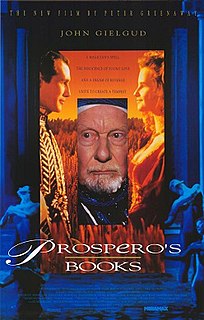
Prospero's Books is a 1991 British avant-garde film adaptation of William Shakespeare's The Tempest, written and directed by Peter Greenaway. Sir John Gielgud plays Prospero, the protagonist who provides the off-screen narration and the voices to the other story characters. As noted by Peter Conrad in The New York Times on 17 November 1991, Greenaway intended the film “as an homage to the actor and to his "mastery of illusion." Sir John's Prospero is Shakespeare, and having rehearsed the action inside his head, speaking the lines of all the other characters, he concludes the film by sitting down to write The Tempest.”

A Zed & Two Noughts is a 1985 film written and directed by Peter Greenaway. This film was Greenaway's first collaboration with cinematographer Sacha Vierny, who went on to shoot virtually all of Greenaway's work in the 1980s and 1990s, until Vierny's death. Greenaway referred to Vierny as his "most important collaborator". The film is a rumination on life, love, bad sex, doubling, man's mistreatment of animals, artifice v. the life force and the inevitability of birth, death and decay.
Joe "Bean" Esposito is an American singer/songwriter whose career spans from the 1970s to the present day. Esposito's songs have been recorded by Donna Summer, Aretha Franklin, Patti Labelle, Stephen Stills and others.
The Michael Nyman Band, formerly known as the Campiello Band, is a group formed as a street band for a 1976 production of Carlo Goldoni's 1756 play, Il Campiello directed by Bill Bryden at the Old Vic. The band did not wish to break up after the production ended, so its director, Michael Nyman, began composing music for the group to perform, beginning with "In Re Don Giovanni", written in 1977. Originally made up of old instruments such as rebecs, sackbuts and shawms alongside more modern instruments like the banjo and saxophone to produce as loud a sound as possible without amplification, it later switched to a fully amplified line-up of string quartet, double bass, clarinet, three saxophones, horn, trumpet, bass trombone, bass guitar, and piano. This line up has been variously altered and augmented for some works.

Michael Nyman is the third album release by Michael Nyman and the second with the Michael Nyman Band, having previously contributed tracks to new music compilations. Most of the music was material from early films by Peter Greenaway such as "Bird List Song" from The Falls, sung by Lucie Skeaping, and music from Act of God and Tree.

"Piano in the Dark" is a song by American singer-songwriter Brenda Russell. It was the first single to be taken from Russell's 1988 album, Get Here.
Noises, Sounds & Sweet Airs is a 1991 opera by Michael Nyman that began as an opera-ballet titled La Princesse de Milan choreographed by Karine Saporta. The libretto is William Shakespeare's The Tempest, as abridged by the composer. The title is derived from Caliban's line, "This isle is full of noises, sounds, and sweet airs, which give delight and hurt not." It premiered in June 1991 in Hérouville-Saint-Clair, Calvados, France, with the L'Ensemble de Basse-Normandie conducted by Dominique Debart. Three members of Saporta's dance company provided the singing.
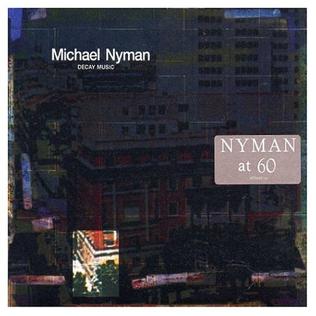
Decay Music is the 1976 debut album by Michael Nyman, released on Brian Eno's Obscure Records music label. The two works on the album, "1-100" and "Bell Set No. 1" (1974) are both built around the musical concept of decay. Both of these experiment with percussive, long decay musical forms. "1-100" is played at half the speed it was recorded. It was written for Peter Greenaway's film of the same title but rejected because it was too long. It was inspired by Frederic Rzewski's Les Moutons de Panurge, which Nyman often played with the Scratch Orchestra.

The Essential Michael Nyman Band is a studio album featuring a collection of music by Michael Nyman written for the films of Peter Greenaway and newly performed by the Michael Nyman Band. It is the seventeenth album release by Nyman. The album features liner notes by Annette Morreau, who describes the album as "a summation and digest of ten years of progress in the performance of music by a composer -- a composer with whom, so evidently, a group of friends and expert musicians intimately identify their total commitment, virtuosity, and joyous enthusiasm."
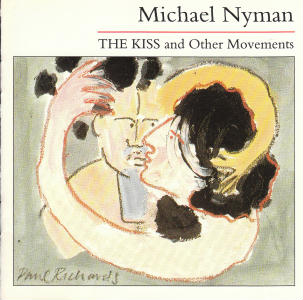
The Kiss and Other Movements is the sixth album release by Michael Nyman, and the fifth recording with the Michael Nyman Band. The title track is an "operatic duet" between Dagmar Krause and Omar Ebrahim, based on a painting of the same title by Paul Richards, which is depicted on the cover, and used in a video art project by Richards of the same name. The album includes music from Peter Greenaway's Making a Splash and 26 Bathrooms, an excerpt of Nyman's unfinished opera, Tristram Shandy, and a concert piece, "Tango Between the Lines".

And Do They Do/Zoo Caprices is the eighth album released by Michael Nyman and the fifth featuring the Michael Nyman Band. And Do They Do is a modern dance work commission by Siobhan Davies and The London Contemporary Dance Theatre, which premiered at Sadler's Wells Theatre on 25 November 1986. Zoo Caprices is a multi-stop violin solo for Alexander Balanescu based on the score for Peter Greenaway's film, A Zed & Two Noughts.
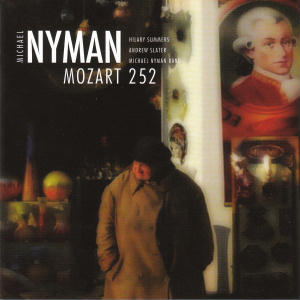
Mozart 252 is a 2008 album by Michael Nyman with the Michael Nyman Band, Hilary Summers, and Andrew Slater, celebrating the 250th anniversary of Wolfgang Amadeus Mozart's birth. Although "Revisiting the Don," one of only two newly written works on the album, was commissioned and performed in 2006, the album's title is a joke on its lateness as an album, released 252 years after Mozart's birth. The album also includes "In Re Don Giovanni," Nyman's first composition for the band, which is based on the first fifteen bars of "Madamina, il catalogo è questo" from Don Giovanni, six selections from Peter Greenaway's film, Drowning by Numbers, in which he was instructed to base the music on the slow movement of Mozart's Sinfonia Concertante K. 364, and two duets and an aria from Nyman's television opera, Letters, Riddles and Writs, in this recording featuring bass Andrew Slater as Leopold Mozart and contralto Hilary Summers as Wolfgang.
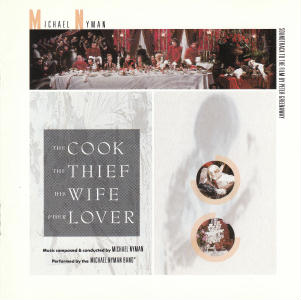
The Cook The Thief His Wife & Her Lover is the twelfth album release by Michael Nyman and the ninth to feature the Michael Nyman Band. It is the soundtrack to the eponymous film by Peter Greenaway. The album includes the first commercially released recording of Memorial, and this is the only piece discussed in the liner notes, to the point that the lyric sheet for "Miserere", the song which Pup the kitchen boy sings, is misidentified "Memorial." "Book Depository" is one of Nyman's many waltzes.

The Piano Concerto/MGV is the 23rd album by Michael Nyman, released in 1994. It contains two compositions, The Piano Concerto and MGV. The first is performed by Kathryn Stott and the Royal Liverpool Philharmonic Orchestra conducted by Michael Nyman, and the second is performed by the Michael Nyman Band and Orchestra with Michael Nyman at the piano.

Alexander Bălănescu is a Romanian violinist, and founder of the Balanescu Quartet.

The Composer's Cut Series Vol. II: Nyman/Greenaway Revisited is the second in a series of albums, all released on the same day, by Michael Nyman to feature concert versions of film scores, in this case, films of Peter Greenaway, and his 52nd release overall. The album is similar to The Essential Michael Nyman Band, although a number of tracks are on only one album or the other. In spite of being recorded in 1992, with the same lineup, Memorial is not the same performance as the one that appears on The Essential Michael Nyman Band or After Extra Time, which was recorded in Tokyo. This performance was recorded in London and is slightly less aggressively performed.
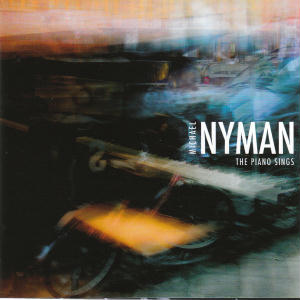
The Piano Sings is a 2005 solo album by Michael Nyman featuring personal interpretations of film music he wrote between 1993 and 2003. It is his second release on his own label, MN Records, and his 49th release overall. The album was released alongside a concert tour.



















